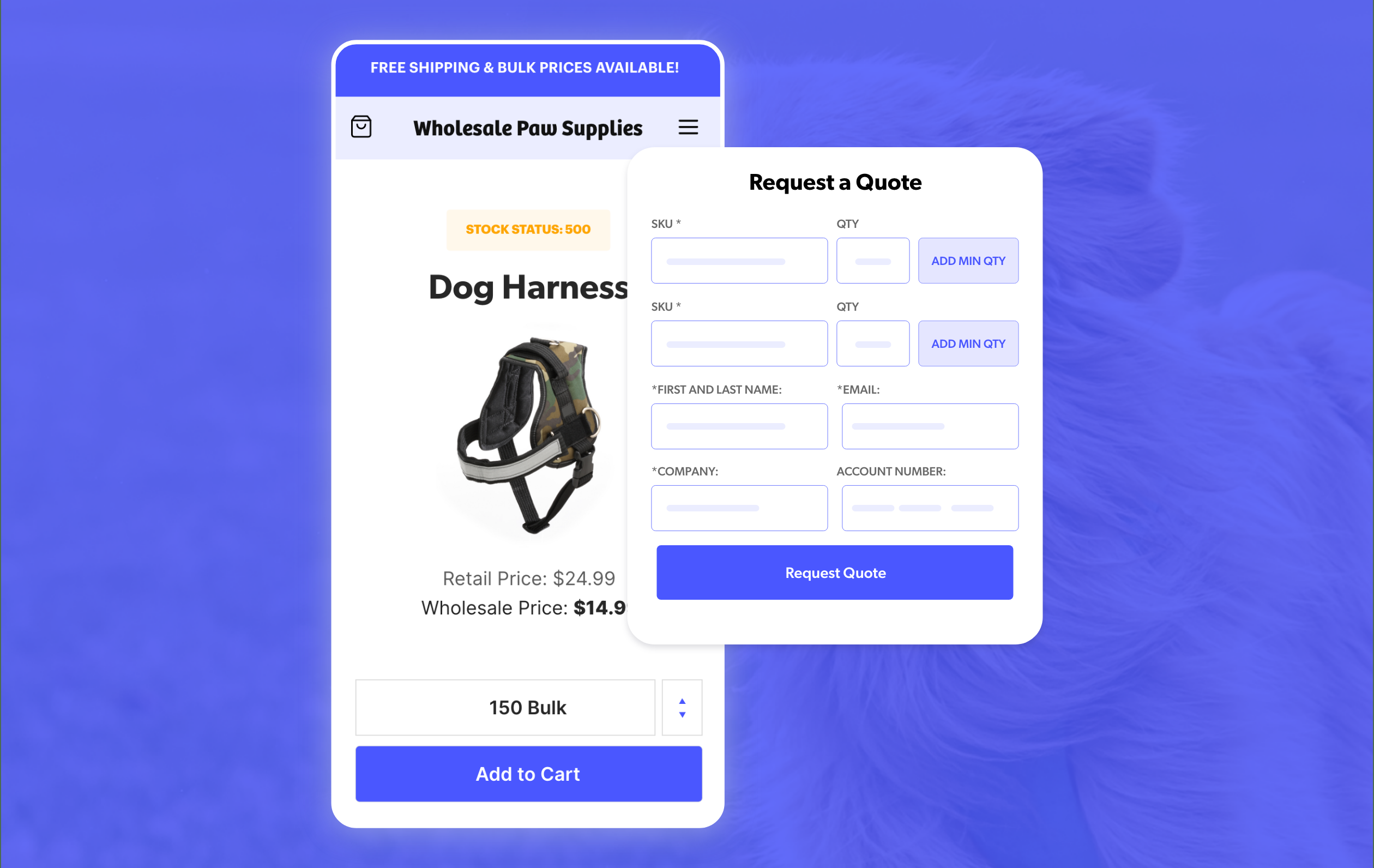By Vanessa Loughty | May 16, 2023

See why top ecommerce brands use Miva’s no-code platform to run
multiple stores, manage massive catalogs, and grow their revenue.
With global revenue projected to reach $350 billion by 2027, the booming pet ecommerce industry presents a golden opportunity for businesses looking to enter or scale up in the popular category. However, selling pet products online at the enterprise level comes with a unique set of challenges, thanks to a broad mix of buying habits, the need to wrangle large inventories of products with unique handling requirements, and an end-consumer who can’t always tell you which products they like the best.
For independent merchants, understanding these complexities and addressing them with a seamless, high-efficiency online shopping experience is the key to attracting and retaining customers. In this blog, we’ll discuss how merchants can fine tune ecommerce strategy to stand out from the competition, and effectively take advantage of the online pet supply boom.
An astounding 86% of pet owners shop for their pet online, and 59% of those shoppers order their pet products from Amazon. This is great news for ecommerce merchants, as shoppers in this category are very comfortable shopping online. However, understanding what drives shoppers is complicated because unlike other ecommerce categories, pet supply businesses also cater to another unique set of customers—the pets themselves. Animals can't always voice their preferences, leading pet owners and pet businesses to seek more background information and relevant recommendations for their purchases. This necessitates an informative ecommerce experience where product descriptions, reviews, promotions, and site design itself play a crucial role in influencing buying decisions.
The retail consumer: Many pet owners view their pets as family and are as focused on product quality, safety, and efficacy as they would be for any family member. Sales methods, site design, and brand content all need to reflect this emotional underpinning, while simultaneously serving proven techniques for appealing to consumers. Dynamic, eye catching promotions, consumer-oriented emotional product descriptions, fast websites, and easy checkouts all appeal to retail shoppers. We wrote more about why fast sites are high performers here.
Product selection is also impacted by the nature of the pet owning audience. For example, the unique relationship between pet owners and the products they buy for their animals could also translate into a willingness to spend more on premium, organic, and specially formulated products. Case in point: the organic pet food industry, despite being relatively new, is worth around $22.8 billion, having more than doubled over the past 10 years.
The B2B buyer: Of course, not all buyers are pet owners. B2B purchasers might be acquiring items for veterinary offices, shelters, or retail businesses. These buyers typically have a more involved purchasing process which may involve multiple stake holders and levels of approval. As a result, this group might value price, efficiency, and a personalized buying journey which saves time by tailoring offerings to specific account terms. Read more about effectively serving your B2B buyers here.
To deliver truly effective pet product ecommerce, sellers often must cater to both of these audiences, frequently from the same ecommerce website.
Pet care businesses often feature very large and complex product catalogs. This is because pet supply sellers typically offer a wide variety of product categories, ranging from food (a massively diverse category unto itself) to toys, accessories, and health care items. Each product may have numerous variations and SKUs, requiring sophisticated inventory management systems and clear, accurate product information to ensure the customer knows exactly what they're purchasing. This blog explores what goes into a perfect product description.
Going digital: Managing a large catalog of products is always one of the key challenges in online business, and this is definitely true for pet ecommerce stores. We wrote in depth about the benefits of a digital product catalog here. A digital product catalog is the best way to wrangle very complex inventories and forms the basis of an entire ecommerce site’s organization.
Live visibility: A key consideration for merchants and customers is achieving real time visibility into product inventory. Tracking, reporting, and posting location and availability of items is an important tool for managing operations as well as keeping customers informed. For this reason, merchants need total control over product data, combined with workflows and integrations which allow them to utilize this information on the website and in back of house operations.
Automating recurring orders: Finding innovative ways to allow customers to interact with the catalog is the heart of a great shopping experience. One of the most common forms of “self-service” features for pet product shoppers is subscription for recurring orders. Because pet products like dog food, waste bags, and health supplements must be used and replenished year-round, subscription services are very popular in pet ecommerce. This is true for retail and B2B buyers, though each might have very different preferences for frequency, bulk pricing, and even order forms. Catering to these unique purchasing needs requires a flexible ecommerce platform that can natively automate recurring orders and payments—we explore the subscription economy in depth in this whitepaper.
Ensuring safety and compliance is a top priority for pet supply sellers, as many products may be perishable (such as raw or refrigerated pet food and treats), have special safety-oriented use instructions, or perhaps are regulated as a medical product. We explored how to sell "challenging" products here. Ensuring strict compliance with safety regulations is essential to keeping pets happy and healthy, maintaining customer trust, and avoiding legal issues. Here are a few ways that ecommerce features can support safety and compliance for your customers:
Pet CBD is an increasingly popular pet product category which has unique safety and regulatory requirements for selling, packaging, and shipping. Around one-third of pet owners have purchased a CBD product for their pets, making it a very lucrative up and coming segment. Outfitting your store to sell CBD pet products requires research into local laws, specific requirements for how you describe items, and careful consideration of who you are marketing products to. We explore everything you need to know to navigate online CBD sales here.
Ready to take your pet supply sales to the next level? Here's a quick checklist for developing successful pet ecommerce on an existing site, or when launching a new business:
1. Ensure your ecommerce platform can manage a large catalog of products/SKUs and their variations.
2. Make your site content information-rich, with detailed product descriptions, reviews, specs, and recommendations.
3. Deploy eye-catching promotions, branding elements, and outstanding product content to stand out in a competitive field. It’s not just about marketing and merchandising—another great way to stand out from competition is by simply offering a faster and more effective shopping experience than other stores.
4. Comply with all safety and regulatory standards, especially when selling perishable or regulated items. Make sure that customers can see your commitment to safety with ample site messaging.
5. Consider the factors that drive different types of buyers, and offer products and pricing which directly appeal to those unique needs. For example, you might offer premium organic products to cater to pet owners' desire to buy high quality items for their pets. Your B2B buyers may also want these products, but they may need to order them in a different way, using bulk pricing, quick order forms, and B2B price quotes.
6. Consider offering subscription services for every pet care item you sell. Subscription purchasing is a universal winner for all types of pet supply buyers.
7. Leverage the growing popularity of CBD pet products by incorporating them into your lineup.
8. Ensure your ecommerce platform can cater to B2B buyers, such as veterinary clinics and resellers, and think about what kinds of customized features will help these buyers have a faster, more effective experience.
Design your site to cater to a diverse audience of pet owners, animal fans, and animal businesses, keeping in mind the different generations and their unique needs and shopping habits. 33% of U.S. pet owners are millennials. Check out these blogs to learn more about how Millennials and Baby Boomers each approach ecommerce.
A robust and agile ecommerce platform is crucial for managing all of these pet ecommerce challenges. The ecommerce platform should offer flexible product catalog management, a broad variety of tools to display and utilize product information, customized safety and compliance features, and easy subscription management. A complete ecommerce system should be capable of simultaneously handling the specific needs of B2B buyers, veterinary clinics, and retail customers, each of whom has unique requirements and shopping habits.
By taking the steps listed above, you can successfully navigate the challenges of pet ecommerce and tap into this growing market today. Remember, the key is to understand your customer, and then help them connect safely with the products they are looking for...even when your customer is a kitten.


Katy Ellquist, Miva’s Digital Marketing Strategist, is an accomplished writer, marketer, and social media analyst who has created sophisticated content campaigns for a broad range of professional clients. She brings to Miva a complex understanding of ecommerce trends and techniques, building upon extensive digital agency experience and a prior role as direct liaison to Miva’s top accounts. Katy is a regular contributor to the Miva blog, covering essential ecommerce topics like design & development strategy, site optimization, and omnichannel selling, with the goal of increasing the actionable knowledgebase of the entire Miva community.
Love it? Share it!
No worries, download the PDF version now and enjoy your reading later...
Download PDF Vanessa Loughty